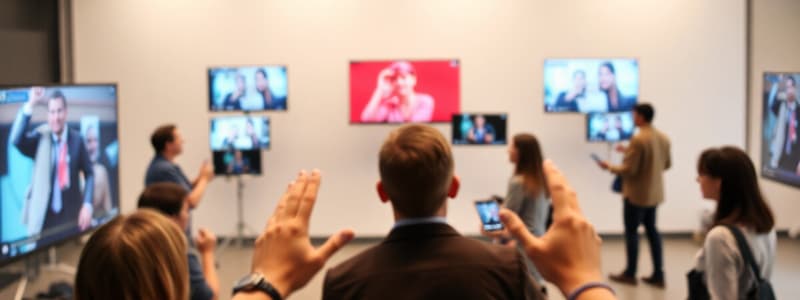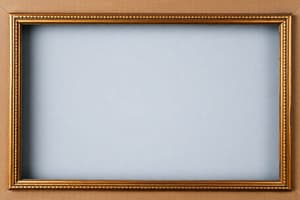Podcast
Questions and Answers
What does framing primarily help individuals achieve in dealing with complex realities?
What does framing primarily help individuals achieve in dealing with complex realities?
- Promoting absolute truth
- Eliminating biases in perception
- Selecting and organizing information (correct)
- Highlighting irrelevant details
Which of the following best describes the relationship between media and framing according to the everyday theory?
Which of the following best describes the relationship between media and framing according to the everyday theory?
- Media can manipulate facts and create oppositions to real truth (correct)
- Media is always a reliable source of information
- Media clearly presents complex realities without distortion
- Media solely reflects objective truths
What aspect of framing allows for the alignment of events to create a unified narrative?
What aspect of framing allows for the alignment of events to create a unified narrative?
- Frame magnification
- Frame articulation (correct)
- Frame separation
- Frame distortion
According to social-scientific theory, what are frames considered as?
According to social-scientific theory, what are frames considered as?
What is a major focus of framing according to Entman et al. (2009)?
What is a major focus of framing according to Entman et al. (2009)?
What concept explains why individuals often avoid extensive thinking when interpreting information?
What concept explains why individuals often avoid extensive thinking when interpreting information?
What role do news frames play according to the content provided?
What role do news frames play according to the content provided?
According to Goffman, what is the 'frame of the activity'?
According to Goffman, what is the 'frame of the activity'?
What did Lippmann note about people's perception of the world?
What did Lippmann note about people's perception of the world?
Which tools do journalists use to create news frames?
Which tools do journalists use to create news frames?
What concept explains the strategic choices actors make in framing situations?
What concept explains the strategic choices actors make in framing situations?
Which statement reflects the relationship between reality and framing according to framing theory?
Which statement reflects the relationship between reality and framing according to framing theory?
What factor does not affect the meaning generated by a frame?
What factor does not affect the meaning generated by a frame?
How does framing theory view agency in relation to material constraints?
How does framing theory view agency in relation to material constraints?
What does the term 'narrative fidelity' refer to in the context of frames?
What does the term 'narrative fidelity' refer to in the context of frames?
Which of the following best describes the diachronic nature of frames?
Which of the following best describes the diachronic nature of frames?
What element is essential for understanding the meanings generated by a frame?
What element is essential for understanding the meanings generated by a frame?
Why is reality essential to framing according to framing analysis?
Why is reality essential to framing according to framing analysis?
What primarily contributes to the novelty of a collective action frame?
What primarily contributes to the novelty of a collective action frame?
Which of the following components is NOT part of a frame as defined by Benford and Snow?
Which of the following components is NOT part of a frame as defined by Benford and Snow?
According to Entman, framing devices are important in establishing which aspect of events?
According to Entman, framing devices are important in establishing which aspect of events?
What does Gamson and Modigliani define framing as?
What does Gamson and Modigliani define framing as?
How does Edelmann describe the social world?
How does Edelmann describe the social world?
What is implied by the active and processual nature of framing?
What is implied by the active and processual nature of framing?
What is the primary function of issue frames according to Entman et al.?
What is the primary function of issue frames according to Entman et al.?
When individuals assess a situation, what question do they essentially ask?
When individuals assess a situation, what question do they essentially ask?
What does the concept of framing imply about how worldviews operate?
What does the concept of framing imply about how worldviews operate?
What does the term 'framing distortion' refer to?
What does the term 'framing distortion' refer to?
Which statement best characterizes the nature of framing?
Which statement best characterizes the nature of framing?
How does framing allow for multiple meanings of the same reality?
How does framing allow for multiple meanings of the same reality?
In the context of ritual slaughter, which framing perspective would most likely emphasize ethical considerations?
In the context of ritual slaughter, which framing perspective would most likely emphasize ethical considerations?
Why is it vital for communication scientists to analyze what gets ignored in framing?
Why is it vital for communication scientists to analyze what gets ignored in framing?
What is often a consequence of framing a subject in a specific way?
What is often a consequence of framing a subject in a specific way?
Which of the following best illustrates the concept of framing as it relates to ritual slaughter?
Which of the following best illustrates the concept of framing as it relates to ritual slaughter?
What does framing allow individuals to do with complex reality?
What does framing allow individuals to do with complex reality?
What implication does the selection process in framing have?
What implication does the selection process in framing have?
How does organization within a frame affect meaning?
How does organization within a frame affect meaning?
Why are frames considered inevitable according to the content?
Why are frames considered inevitable according to the content?
According to the content, what is the consequence of lacking a frame?
According to the content, what is the consequence of lacking a frame?
What role do anecdotes and stereotypes play in framing?
What role do anecdotes and stereotypes play in framing?
What does Goffman's concept of 'frame of the activity' emphasize?
What does Goffman's concept of 'frame of the activity' emphasize?
In the context of framing, how is reality characterized?
In the context of framing, how is reality characterized?
What is the primary function of a frame?
What is the primary function of a frame?
Which statement best reflects the idea of ideological coloring in understanding reality?
Which statement best reflects the idea of ideological coloring in understanding reality?
Flashcards
Framing Analysis
Framing Analysis
A method for analyzing communication, focusing on how a message is structured and presented to influence how it is understood.
Frames
Frames
Mental blueprints or frameworks that people use to filter information, organize experiences, and interpret reality.
Frame Articulation
Frame Articulation
The process of deliberately choosing specific aspects of a story and highlighting them to influence how an audience understands an issue or event.
Applications of Framing Theory
Applications of Framing Theory
Signup and view all the flashcards
Lasswell's Formula
Lasswell's Formula
Signup and view all the flashcards
Framing
Framing
Signup and view all the flashcards
Cognitive Misers
Cognitive Misers
Signup and view all the flashcards
Cognitive Misers and Frames
Cognitive Misers and Frames
Signup and view all the flashcards
Frames and Limited Information
Frames and Limited Information
Signup and view all the flashcards
Media Framing
Media Framing
Signup and view all the flashcards
Diagnosis
Diagnosis
Signup and view all the flashcards
Propositions
Propositions
Signup and view all the flashcards
Motivation
Motivation
Signup and view all the flashcards
Naturalized Frames
Naturalized Frames
Signup and view all the flashcards
Active, Processual Phenomenon
Active, Processual Phenomenon
Signup and view all the flashcards
What are frames?
What are frames?
Signup and view all the flashcards
Why do we need frames?
Why do we need frames?
Signup and view all the flashcards
How do frames select information?
How do frames select information?
Signup and view all the flashcards
How do frames influence understanding?
How do frames influence understanding?
Signup and view all the flashcards
How do frames organize information?
How do frames organize information?
Signup and view all the flashcards
Why are frames necessary for action?
Why are frames necessary for action?
Signup and view all the flashcards
Are frames neutral or ideological?
Are frames neutral or ideological?
Signup and view all the flashcards
Are frames inevitable?
Are frames inevitable?
Signup and view all the flashcards
Why is framing theory important?
Why is framing theory important?
Signup and view all the flashcards
How is reality turned into information?
How is reality turned into information?
Signup and view all the flashcards
Frames and Neutrality
Frames and Neutrality
Signup and view all the flashcards
Beyond the Frame
Beyond the Frame
Signup and view all the flashcards
Infinite Realities
Infinite Realities
Signup and view all the flashcards
Everyday Framing
Everyday Framing
Signup and view all the flashcards
Framing in Communication
Framing in Communication
Signup and view all the flashcards
Limits of Framing
Limits of Framing
Signup and view all the flashcards
Framing as a Process
Framing as a Process
Signup and view all the flashcards
Framing as an Active Process
Framing as an Active Process
Signup and view all the flashcards
Context Matters for Framing
Context Matters for Framing
Signup and view all the flashcards
Frame as a Lens on Reality
Frame as a Lens on Reality
Signup and view all the flashcards
Frames as Shared Patterns
Frames as Shared Patterns
Signup and view all the flashcards
Reality Limits Framing
Reality Limits Framing
Signup and view all the flashcards
Framing Analysis & Strategic Choices
Framing Analysis & Strategic Choices
Signup and view all the flashcards
Framing Theory: Agency and Structure
Framing Theory: Agency and Structure
Signup and view all the flashcards
Framing as a Strategy
Framing as a Strategy
Signup and view all the flashcards
Study Notes
Communication Science
- Dr. Elke Mahieu is the lecturer.
Lasswell's Formula (1948)
- What?: What content? What is the meaning of the message?
- To Whom?: Who is the public? To whom is the message addressed? What are the characteristics of the audience?
- Who?: Which individuals? Which organizations?
- Why?: What is the intended and actual effect of the message? What does the message try to achieve?
- And How?: Which channels are being used? What technology is being deployed? How is the message conveyed?
Framing Analysis
- Framing is a theory of content and meaning.
Framing as an Everyday Theory
- Related to media and how they present facts.
- Implies that media can be biased (lies, manipulation, twisting facts).
- There's an opposition between the real truth and media's portrayal.
Fox News v. Fox News Latino
- Analysis of how different versions of a single story are presented for different targets.
Framing as a Social-Scientific Theory
- Definitions:
- Frames are cognitive schemata that allow interpretation
- The essence of framing is making elements more or less prominent. (sizing, magnifying or shrinking elements).
- Articulation connects and aligns events.
Framing as a Social-Scientific Theory (continued)
- The Organization of Experience (Goffman): How we understand our reality, including the subjective component of our involvement.
- Elements of Frames (Benford & Snow): A diagnosis of the problem, solutions/tactics, and motivating for action.
- Frames as "natural" Choices: Framing devices seem unremarkable, but choices in wording and images are crucial to the meaning.
Framing as a Social-Scientific Theory (continued)
- Frames describe a "kaleidoscope of potential realities," as reality can be altered through differing interpretations.
Framing as a Social-Scientific Theory (continued)
- Frames help individuals answer "what's going on here?", using basic organizational premises both in minds and activities. (Goffman).
- Frames provide a quick way to process information (cognitive misers), thus contributing to a way of making sense of the world (Fiske & Taylor).
Framing as a Social-Scientific Theory (continued)
- Media as "the chief of symbolic contact" provides influence over public opinion, perceptions, and behavior.
- The news media structure and organize reality into coherent events, using language (metaphors, examples, catchphrases, etc.).
Framing as a Social-Scientific Theory (continued)
- Takeaways: Reality is complex. Frames transform it into manageable information.
- Selection (cutting or splicing): Some aspects of reality get left out of frames.
Framing as a Social-Scientific Theory (continued)
- Frames are necessary for understanding and acting in the world.
- Meaningful pictures are crucial to organize a reality otherwise too complex.
- Worldviews are always inherently ideological and perspectival.
Framing-Scientific versus Everyday
- Scientific framing focuses on selection and inclusion within and outside of the frame, as opposed to the bias and distortion implied in the everyday understanding.
Framing and Infinite Realities
- Examples explore how the same issue (e.g., ritual slaughter of animals without stunning) can be framed in many different ways. (e.g., religious, economic, ethical, etc.).
Agency and Structure
- Framing is an active process, and actors make conscious choices when framing a situation.
Framing as Political/Media Strategy
- Framing can be a deliberate tactic for influencing audiences, as seen in examples like political communications and media coverage (e.g., coverage of specific conflicts).
Reality Limits Framing
- Framing is limited by the material reality, which means frames (at least in part) can't be entirely arbitrary.
- Frame take pre-existing cultural, social, and other contexts into account-- affecting meaning.
Meaning Depends on Context
- The meaning of any frame is contingent on and influenced by its context of production, display, and reception.
Frames Matter
- Frames have real power in changing how people perceive and react to information and situations (e.g., influencing political agendas, public perception).
- If messages are framed consistently, people tend to accept one frame as true (e.g. cultivation or spiral of silence).
Studying That Suits You
Use AI to generate personalized quizzes and flashcards to suit your learning preferences.




